英文论文结构简介 pt
- 格式:ppt
- 大小:123.00 KB
- 文档页数:15
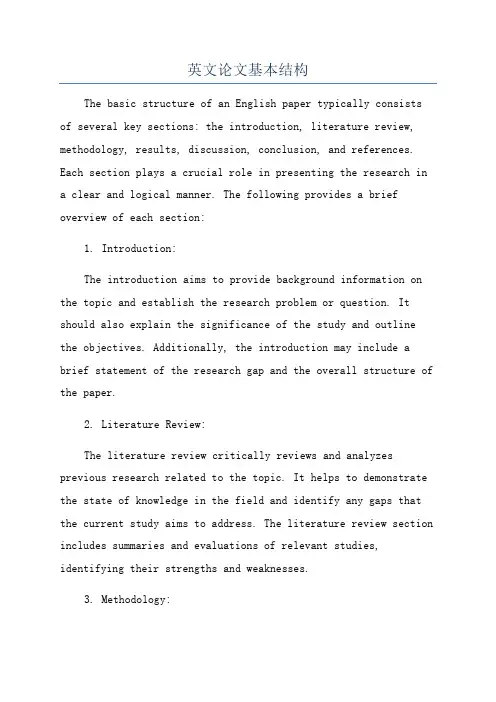
英文论文基本结构The basic structure of an English paper typically consists of several key sections: the introduction, literature review, methodology, results, discussion, conclusion, and references. Each section plays a crucial role in presenting the research in a clear and logical manner. The following provides a brief overview of each section:1. Introduction:The introduction aims to provide background information on the topic and establish the research problem or question. It should also explain the significance of the study and outline the objectives. Additionally, the introduction may include a brief statement of the research gap and the overall structure of the paper.2. Literature Review:The literature review critically reviews and analyzes previous research related to the topic. It helps to demonstrate the state of knowledge in the field and identify any gaps that the current study aims to address. The literature review section includes summaries and evaluations of relevant studies, identifying their strengths and weaknesses.3. Methodology:The methodology section describes the research design, participants, materials, and procedures used in the study. It explains how data was collected or generated and provides details about the data analysis techniques employed. This section enables other researchers to replicate the study and assess the reliability of the findings.4. Results:The results section presents the findings derived from the data analysis. It typically includes statistical analyses, figures, and tables that summarize and interpret the data. The results should be presented objectively without interpretation or discussion.5. Discussion:6. Conclusion:The conclusion summarizes the main findings of the study, reiterating their significance and potential implications. It should address the research question and briefly recapitulate the key points discussed in the paper. Additionally, the conclusion may suggest areas for further research or practical applications of the findings.7. References:The references section lists all the sources cited in the paper using a specific citation style such as APA or MLA. It isimportant to accurately and consistently document the sources to avoid plagiarism and provide readers with the means to locate the referenced material.。
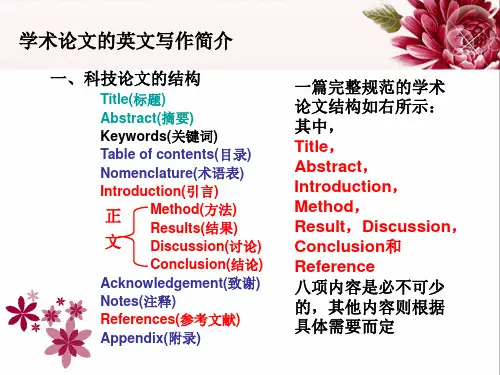

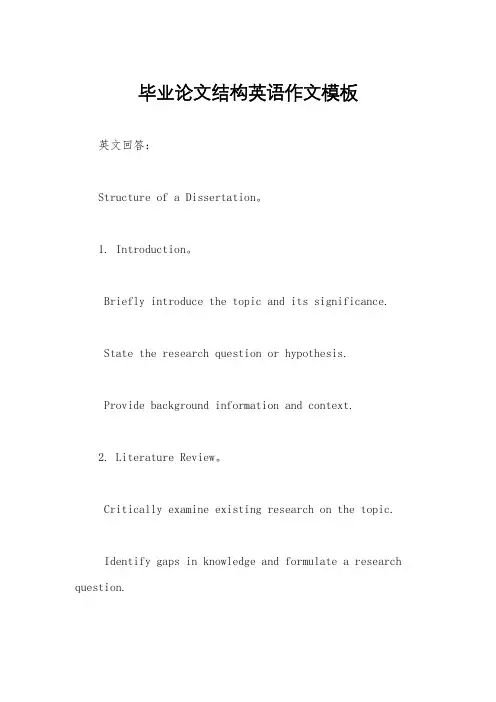
毕业论文结构英语作文模板英文回答:Structure of a Dissertation。
1. Introduction。
Briefly introduce the topic and its significance. State the research question or hypothesis.Provide background information and context.2. Literature Review。
Critically examine existing research on the topic.Identify gaps in knowledge and formulate a research question.Establish the theoretical framework for the dissertation.3. Methodology。
Describe the research design, methods, and data collection techniques.Justify the choice of methodology and ensure its validity and reliability.Outline the ethical considerations of the research.4. Results。
Present the findings from the data analysis.Use tables, charts, and figures to illustrate the results.Discuss the implications of the findings.5. Discussion。
Interpret the results in light of the research question and theoretical framework.Relate the findings to existing literature and identify areas of convergence and divergence.Discuss the limitations of the study and suggest directions for future research.6. Conclusion。
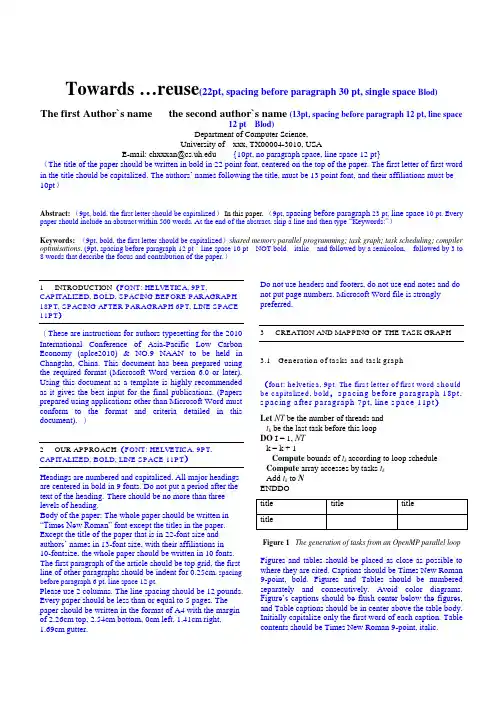
Towards …reuse(22pt, spacing before paragraph 30 pt, single space Blod)The first Author`s name the second author`s name(13pt, spacing before paragraph 12 pt, line space12 pt Blod)Department of Computer Science,University of xxx, TX00004-3010, USAE-mail: chxxxan@{10pt, no paragraph space, line space 12 pt}(The title of the paper should be written in bold in 22 point font, centered on the top of the paper. The first letter of first word in the title should be capitalized. The authors‟ names following the title, must be 13 point font, and their affiliations must be 10pt)Abstract:(9pt, bold, the first letter should be capitalized)In this paper, (9pt, spacing before paragraph 23 pt, line space 10 pt. Every paper should include an abstract within 500 words. At the end of the abstract, skip a line and then type “Keywords:”)Keywords:(9pt, bold, the first letter should be capitalized)shared memory parallel programming; task graph; task scheduling; compiler optimisations. (9pt, spacing before paragraph 12 pt line space 10 pt NOT bold italic and followed by a semicolon, followed by 3 to 8 words that describe the focus and contribution of the paper.)1 INTRODUCTION(FONT: HELVETICA, 9PT, CAPITALIZED, BOLD, SPACING BEFORE PARAGRAPH 18PT, SPACING AFTER PARAGRAPH 6PT, LINE SPACE 11PT)(These are instructions for authors typesetting for the 2010 International Conference of Asia-Pacific Low Carbon Economy (aplce2010) & NO.9 NAAN to be held in Changsha, China. This document has been prepared using the required format (Microsoft Word version 6.0 or later). Using this document as a template is highly recommended as it gives the best input for the final publications. (Papers prepared using applications other than Microsoft Word must conform to the format and criteria detailed in this document). )2 OUR APPROACH(FONT: HELVETICA, 9PT, CAPITALIZED, BOLD, LINE SPACE 11PT)Headings are numbered and capitalized. All major headings are centered in bold in 9 fonts. Do not put a period after the text of the heading.There should be no more than three levels of heading.Body of the paper: The whole paper should be written in “Times New Roman” font except the titles in the paper. Except the title of the paper that is in 22-font size and authors‟ names in 13-font size, with their affiliations in10-fontsize, the whole paper should be written in 10 fonts. The first paragraph of the article should be top grid, the first line of other paragraphs should be indent for 0.25cm, spacing before paragraph 6 pt, line space 12 pt.Please use 2 columns. The line spacing should be 12 pounds. Every paper should be less than or equal to 5 pages. The paper should be written in the format of A4 with the margin of 2.26cm top, 2.54cm bottom, 0cm left, 1.41cm right,1.69cm gutter. Do not use headers and footers, do not use end notes and do not put page numbers. Microsoft Word file is strongly preferred.3 CREATION AND MAPPING OF THE TASK GRAPH 3.1 Generation of tasks and task graph(font: helvetica, 9pt. The first letter of first word should be capitalized, bold,spacing before paragraph 18pt, spacing after paragraph 7pt, line space 11pt)Let NT be the number of threads andt k be the last task before this loopDO I = 1, NTk = k + 1Compute bounds of t k according to loop schedule Compute array accesses by tasks t kAdd t k to NENDDOFigure 1 The generation of tasks from an OpenMP parallel loop Figures and tables should be placed as close as possible to where they are cited. Captions should be Times New Roman 9-point, bold. Figures and Tables should be numbered separately and consecutively. Avoid color diagrams. Figure‟s captions should be flush center below the figures, and Table captions should be in center above the table body. Initially capitalize only the first word of each caption. Table contents should be Times New Roman 9-point, italic.All equations should be placed on separate lines and numbered consecutively, with the equation numbers placed within parentheses and aligned against the right margin.Figure 18 ADI kernel code ACKNOWLEDGEMENT(FONT: HELVETICA, 9PT, CAPITALIZED, BOLD)Use the singular heading even if you have many acknowledgments.Sponsor and financial support acknowledgments expre ssions such as “This research was supported by the National Natural Science Foundation of China under Grant 123456”.REFERENCES(FONT: HELVETICA, 9PT, CAPITALIZED, BOLD)Balasundaram, V. and Kennedy, K. (1989) …A techniques for summarising data access and its use in parallelism enhancing transformations‟, Proceedings of ACM SIGPLAN’89 Conference on Programming Language Design and Implementation, June.Hanging indent 0.51cm, line space 10 pt。

学术英语写作的结构
学术英语写作的结构通常遵循一定的模式,以下是一种常见的结构:1.引言(Introduction):在引言部分,作者简要介绍论文的主题、
研究背景、研究目的和研究问题。
此外,还可以提供一些相关的文献综述,以帮助读者更好地理解论文的背景和重要性。
2.文献综述(Literature Review):文献综述部分对已有的相关研究
进行总结和分析,为论文的研究问题提供理论支持和背景信息。
这一部分应该包括对相关研究的批判性评价,以及当前研究的空白和需要进一步探讨的问题。
3.研究方法(Research Methodology):在研究方法部分,作者详细
介绍研究设计、数据采集和分析方法、样本和抽样方法等。
这一部分应该清楚地说明研究是如何实施的,以及如何收集和分析数据的。
4.结果与讨论(Results and Discussion):结果与讨论部分呈现研究
结果,并对结果进行解释和讨论。
这一部分应该包括对数据的描述性分析、推断性分析和解释性分析,以及对结果的讨论和意义。
5.结论(Conclusion):结论部分总结论文的主要发现和贡献,并对
未来研究提出建议。
这一部分应该强调研究的局限性、对理论和实践的贡献,以及对未来研究的启示。
6.参考文献(References):参考文献部分列出文中引用的各篇文献,
按照规定的格式编排,如APA、MLA等。
这一部分应该包括所有引用的文献,以便读者查阅和核实。
以上是一种常见的学术英语写作结构,但具体的结构安排可能因学科领域、论文类型和个人偏好而有所不同。
在写作时,作者应该根据论文的具体要求和规范进行适当的调整。

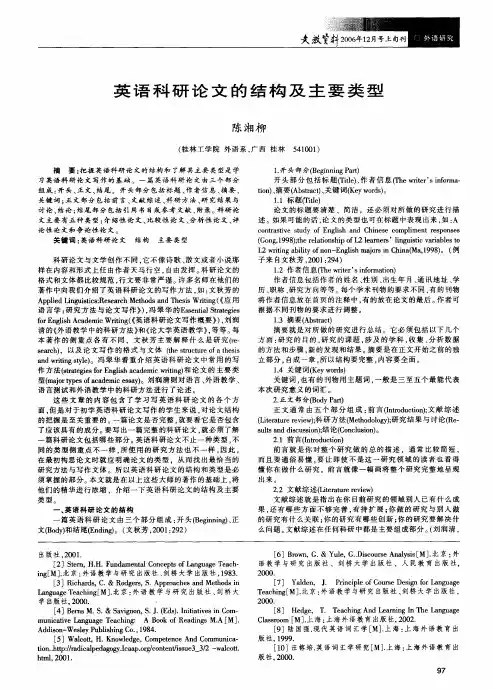
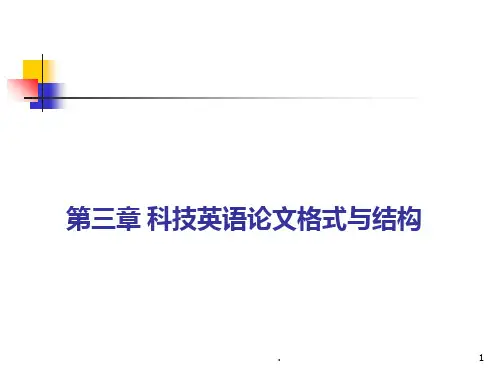
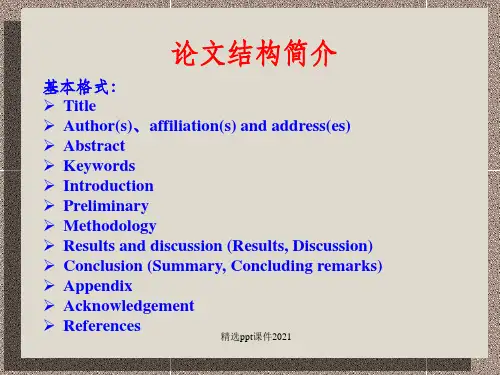

(一) 英文议论文的结构特点要求文章结构必须十分严谨,文章各个部分的功能都要十分清晰,开头、中间和结尾都有严格的要求。
英语议论文共有三大特点:1、观点鲜明的开头;2、紧扣主题的结尾;3、有主题句并且衔接自然的中间段落另外,英语文章和汉语不同的是段落的主题句一定要放在段首,而不能按照中文的写作习惯放在段落的中间或者最后,换句话说,每段的内容都是根据首句来展开的,其顺序不能颠倒。
在中心统一这个问题,应该遵循英文议论文的写作思路和习惯:表示支持则旗帜鲜明地支彻彻底底地反对,而不能采取“墙头草两边倒”的做法。
(二) 作文开头1-1 对立法: 先引出其他人的不同看法,然后提出自己的看法或者偏向于某一看法,适用于有争议性的主题.[1]. When asked about....., the vast/overwhelming majority of people say that ....... But I think/view a bit differently.[2]. When it comes to .... , some people believe that ....... Others argue/claim that the opposite/reverse is true . There is probably some truth in both arguements/statements , but (I tend to the profer/latter ...)[3]. Now, it is commonly/generally/widely believed/held/acknowledged that .... They claim/believe/argue that ... But I wonder/doubt whether.....1-2 现象法引出要剖析的现象或者问题, 然后评论.[1]. Recently the rise in problem of/(phenomenon of) ... has cause/aroused public/popular/wide/worldwide concern.[2]. Recently the issue of the problem of/the phenomenon of ...has been brought into focus. ( has been brouth to public attention)[3].Inflation/Corruption/Social inequality ... is yet another of the new and bitter truth we have to learn to face now/constantly.1-3 观点法----开门见山,直接了当地提出自己对要讨论的问题的看法.[1]. Never history has the change of .. been as evident as ...Nowhere in the world/China has the issue/idea of .. been more visible/popular than...[2]. Now people in growing/significant numbers are beginnig/coming to realize/accept/(be aware) that...[3]. Now there is a growing awareness/recognation ot the necessity to......Now people become increasingly aware/conscious of the importance of ......[4]. Perhaps it is time to have a fresh look at the attitude/idea that.......1-4 引用法----- 先引出名人名言或者有代表性的看法, 来引出文章要展开论述的观点![1]. "Knowledge is power." such is the remark made by Bacon.This remark has been shared by more and more people ."Education is not complete with gradulation." Such is the opnion of a great American philosopher. Now more and more people share his opnion.[2]."........." How often we hear such statements/words like thoses/this .In our own days we are used to hearing such traditional complains as this "......". 1-5 比较法------ 通过对过去,现在两种不同的倾向,观点的比较, 引出文章要讨论的观点.[1]. For years, ...had been viewed as ... But people are taking a fresh look now. With the growing ... , people ....... .[2]. People used to think that ... (In the past, ....) But people now share this new .1-6 问题法----- 先用讨论或解答的设问, 引出自己观点, 适用于有争议性的话题.Should/What ...... ? Options of ... vary greatly , some ..., others ...But in my opinion , ...... .(三)作文结尾结尾万能公式一:如此结论。
介绍论文结构英文作文英文:When it comes to the structure of a paper, there are several key components that must be included. These components are the introduction, literature review, methodology, results, discussion, and conclusion. 。
The introduction is where you provide background information on the topic and state your research question or hypothesis. This section should also include a brief overview of the research that has already been conducted on the topic.The literature review is where you provide an in-depth analysis of the existing research on the topic. This section should highlight any gaps in the research that your study aims to fill.The methodology section is where you explain themethods you used to conduct your research. This section should include information on the participants, materials, and procedures used in your study.The results section is where you present the findings of your study. This section should be presented in a clear and concise manner, using tables and figures to help illustrate your results.The discussion section is where you interpret your results and explain their significance. This section should also include a discussion of any limitations of your study and suggestions for future research.Finally, the conclusion is where you summarize your findings and their implications. This section should also include any recommendations for future research orpractical applications of your findings.中文:论文的结构包括引言、文献综述、方法、结果、讨论和结论等几个关键部分。
英语文章结构英语文章的结构通常遵循“引言-正文-结论”(Introduction-Body-Conclusion)的基本框架。
以下是对这三个部分的详细描述:1. 引言(Introduction):引言是文章的开头部分,主要目的是引出话题并引起读者的兴趣。
引言通常包括背景信息、文章主题和论文陈述。
通过引言,作者为正文部分做好铺垫,让读者了解文章的大致内容和方向。
引言的结构可以包括以下要素:- 背景信息:简要介绍与文章主题相关的背景信息,为读者提供基本的了解。
- 主题陈述:明确指出文章的主题,展示文章的核心内容。
- 论文陈述:提出文章的主要观点和论点,简要概括文章的结论。
2. 正文(Body):正文是文章的核心部分,主要包含文章的论证和论据。
正文通常分为若干段落,每个段落阐述一个主要观点并辅以相关的证据和例子。
段落之间应保持逻辑清晰、连贯一致。
正文的结构可以包括以下要素:- 主题句:每个段落的首句,概括段落的主要观点。
- 论证:提供支持主题句的证据和例子,使观点更具说服力。
- 反例与反驳:针对可能的反对意见提出反例,并加以反驳,使论证更加严密。
- 转折与过渡:使用适当的转折词和过渡句,使段落之间保持连贯性。
3. 结论(Conclusion):结论是文章的结尾部分,主要目的是总结全文的主要观点,并给读者留下深刻印象。
结论应简洁明了,避免引入新的观点或证据。
结论的结构可以包括以下要素:- 总结:简要回顾文章的主要观点和论据,强调文章的核心内容。
- 意义:指出文章的贡献和意义,展示其对读者和研究的价值。
- 建议与展望:提出未来研究的方向和建议,启发读者的思考。
总之,英语文章结构遵循“引言-正文-结论”的基本原则,通过引言引出话题,正文进行论证,结论进行总结,使文章条理清晰、逻辑严密。
在撰写英语文章时,作者应关注这三个部分的结构和要素,以确保文章的质量。
pt结构式PT结构式是一种常用的文章结构,由问题(Problem)和解决方案(Solution)两部分组成。
在这篇文章中,我们将探讨PT结构式的作用和应用。
问题(Problem)部分是文章的开头,用于引起读者的兴趣并提出待解决的问题。
这个问题可以是实际生活中的困惑,也可以是学术领域中的疑问。
在这个部分,我们需要明确问题的背景和重要性,并提出具体的问题陈述。
解决方案(Solution)部分是文章的主体,用于提供解决问题的方法和策略。
在这个部分,我们需要详细阐述解决问题的步骤和技巧,并给出具体的实例或案例来支持我们的观点。
同时,我们还可以引用相关的研究成果或专家观点来加强我们的论述。
在解决方案部分中,我们可以使用恰当的段落和标题来使文章结构清晰,易于阅读。
例如,我们可以使用一级标题来介绍解决方案的整体思路,然后使用二级标题来详细介绍每个步骤或技巧。
同时,我们还可以使用恰当的连接词和过渡句来使文章的逻辑关系更加流畅,确保读者能够理解和接受我们的观点。
在写作过程中,我们应该避免重复问题和自我介绍,以免让读者感到无聊或冗长。
我们还需要注意使用准确严谨的语言,避免歧义或错误信息的出现。
为了使文章更加生动有趣,我们可以使用丰富多样的词汇和表达方式,同时还可以加入一些有趣的事例或引用来吸引读者的注意力。
总结起来,PT结构式是一种有效的文章组织方式,通过明确问题和提供解决方案来引导读者思考和理解。
在使用PT结构式时,我们应该注意内容的准确性和严谨性,并避免重复和冗长。
同时,我们还可以使用恰当的段落和标题来使文章结构清晰,易于阅读。
希望本文能对你理解和应用PT结构式有所帮助。
pt结构式
PT结构式是一种常见的文章结构,适用于各种类型的文章,如新闻报道、科技论文、散文等。
PT结构式分为两个部分,即P段和T段。
T段是文章的主体部分,用来解决问题或者展开论述。
在本文中,我们将通过以下几个方面来介绍如何写一篇符合要求的文章。
我们要注意文章的格式和结构。
一个整洁规范的文章应该有清晰的段落和标题,使读者能够轻松地阅读和理解文章的内容。
在写作过程中,我们可以使用适当的标题来划分不同的主题,使文章的结构更加清晰。
我们要注意避免重复内容。
文章中的每个段落都应该有独特的信息和观点,避免重复表达同样的内容。
这样可以提高文章的可读性和吸引力。
我们要注意使用丰富的词汇和通顺的语句。
通过使用多样化的词汇和灵活的语句结构,可以使文章更加生动有趣,同时也能展示作者的语言表达能力。
我们要注意准确性和严谨性。
在撰写文章时,要避免使用歧义或错误的信息,确保所表达的观点和观点都是准确可靠的。
同时,我们也要注意避免主观偏见和不完整的信息,以确保文章的客观性和权威性。
我们要注意符合其他要求,如不输出http地址、不输出公式等。
这些规定是为了保证文章的纯文本性质,使读者能够专注于文章的内容,而不被其他外部链接或复杂的数学公式所干扰。
通过遵循PT结构式和注意以上几个方面,我们可以写一篇符合要求的文章。
这样的文章将具有清晰的结构、丰富的词汇、准确的信息和通顺的语句,能够吸引读者的注意力,并使读者更好地理解和掌握文章的内容。
希望本文对您有所帮助,谢谢阅读!。